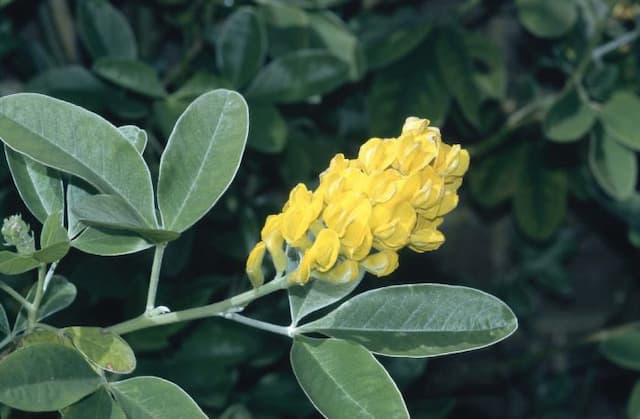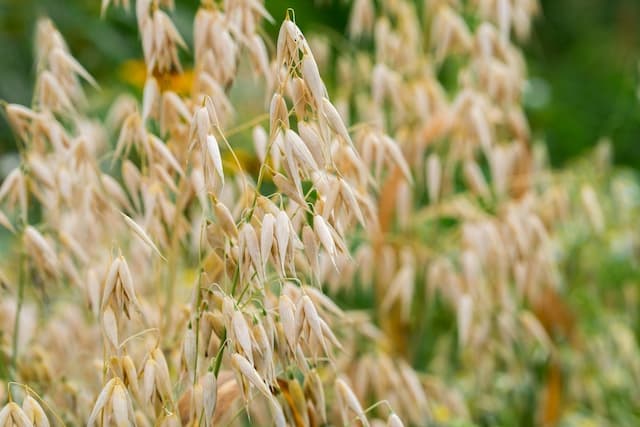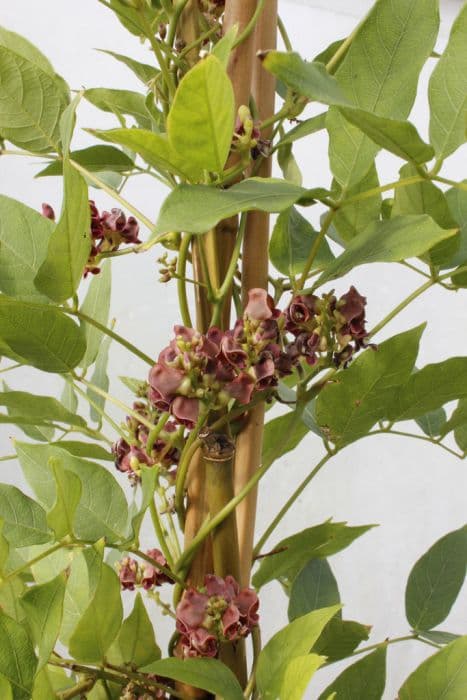Golden Chain Tree Laburnum × watereri

ABOUT
The plant in question, commonly known as the Golden Chain Tree, is a strikingly beautiful ornamental specimen well-appreciated for its decorative appeal. It is characterized by its vibrant display of pendulous clusters of yellow flowers that resemble a chain, giving it its common name. These flower racemes can dangle attractively and add a splash of bright color to the landscape. The leaves of the Golden Chain Tree are green, compound, and often trifoliate, meaning they usually have three leaflets per leaf. The leaflets are notably smooth-edged and have a soft, slightly glossy appearance which provides a lush backdrop for the pronounced floral clusters. It is important to note while discussing this plant that, despite its charm, it contains parts that are toxic if ingested, thus requiring careful placement when planted in areas accessed by children or pets. The overall aesthetic of the Golden Chain Tree lends itself well to various garden styles, especially those seeking to add vertical visual interest with a display of its golden-hued blossoms.
About this plant
 Names
NamesFamily
Fabaceae.
Synonyms
Waterer's Laburnum, Voss's Laburnum, Voss's Golden Chain, Watereri Laburnum.
Common names
Laburnum alpinum × Laburnum anagyroides, Laburnum watereri.
 Toxicity
ToxicityTo humans
The most common common name for Laburnum × watereri is Golden Chain Tree. The Golden Chain Tree is considered highly toxic to humans. All parts of the plant, especially the seeds, contain cytisine, an alkaloid that can cause serious poisoning. If ingested, symptoms of poisoning may include nausea, vomiting, convulsions, and in severe cases, it can lead to coma or even be fatal. Extreme caution should be exercised to prevent ingestion, particularly in children who might be attracted to the plant's seeds.
To pets
The most common common name for Laburnum × watereri is Golden Chain Tree. This plant is highly toxic to pets as well as humans. Similar to its effects in humans, all parts of the Golden Chain Tree are poisonous to pets, including its seeds. The toxic principle is the alkaloid cytisine. Poisoning symptoms in pets can include vomiting, difficulty in coordination, convulsions, and even lead to respiratory failure and death. Pet owners should prevent their animals from having access to this plant.
 Characteristics
CharacteristicsLife cycle
Perennials
Foliage type
Deciduous
Color of leaves
Green
Flower color
Yellow
Height
20 feet (6 meters)
Spread
10 feet (3 meters)
Plant type
Tree
Hardiness zones
5
Native area
Europe
Benefits
 General Benefits
General Benefits- Ornamental Value: Laburnum watereri, commonly known as golden chain tree, is valued for its stunning yellow pea-like flowers that cascade in long racemes in late spring to early summer.
- Shade Provider: The tree's canopy offers a comfortable dappled shade, ideal for creating cool and relaxing outdoor spaces.
- Habitat for Wildlife: Its blossoms attract bees and other pollinating insects, providing a valuable food source for local wildlife.
- Landscape Structure: It can serve as a focal point in a landscape design, providing height and structure with its arched branches.
- Seasonal Interest: The tree adds seasonal interest to gardens with its bright flowering in spring and green foliage that turns yellow in the fall.
- Compact Size: With a relatively small size for a tree, it is suitable for smaller gardens where space might be limited.
 Medical Properties
Medical PropertiesThis plant is not used for medical purposes.
 Air-purifying Qualities
Air-purifying QualitiesThis plant is not specifically known for air purifying qualities.
 Other Uses
Other Uses- The wood of Laburnum × watereri, or golden chain tree, is hard and dense, which allows it to be used for turning on a lathe to create small items such as decorative bowls or pens.
- Due to its durability, the wood can also be used to craft musical instruments like flutes or recorders, offering a rich and warm resonance.
- Golden chain tree's dense wood makes it suitable for making fine handles for tools or walking sticks due to its ability to withstand wear and tear over time.
- The bright yellow flowers and attractive foliage of the golden chain tree are sometimes used in landscape photography and painting as a vibrant focal point in compositions.
- Golden chain tree branches can be incorporated into floral arrangements, especially in spring when the tree is in full bloom, to add height and a splash of color.
- In educational settings, the tree can be used to discuss plant toxicity, as it's a good example of a plant that is highly toxic if ingested.
- The tree is sometimes planted as a bee attractant, as its flowers produce nectar that is appealing to bees and other pollinators.
- Golden chain tree is used to create natural fences or screens when planted in a row, providing both privacy and decorative appeal with its cascading yellow flowers.
- Its wood can also be used in smoking foods, as some enthusiasts claim it imparts a unique flavor, although caution must be taken due to its toxicity.
- The golden chain tree can be used in bonsai culture, where its distinct flowering can create stunning miniaturized versions of the full-sized tree.
Interesting Facts
 Feng Shui
Feng ShuiThe Golden Chain is not used in Feng Shui practice.
 Zodiac Sign Compitability
Zodiac Sign CompitabilityThe Golden Chain is not used in astrology practice.
 Plant Symbolism
Plant Symbolism- Beauty: The Laburnum × watereri, commonly known as Golden Chain or Golden Rain, is admired for its stunning cascades of yellow flowers that add splendid beauty to any landscape.
- Beware of Appearances: Despite its attractive appearance, the plant is highly toxic, which might symbolize the idea that something beautiful can also be dangerous.
- Transient Nature of Life: The Golden Chain's blooming period is relatively short, which can serve as a reminder of the ephemeral nature of life and beauty.
- Caution: The entire plant, especially the seeds, is highly poisonous. Its symbolism can thus extend to cautioning against risks and the importance of recognizing potential hazards.
 Water
WaterGolden Chain trees, as Laburnum × watereri is commonly known, should be watered deeply and less frequently to encourage deep rooting, particularly in their first growing season. Aim to keep the soil uniformly moist but not waterlogged. In the absence of rainfall, water approximately once a week, allowing approximately 1 - 1.5 gallons of water for each inch of the tree trunk's diameter at breast height. During hot, dry periods, increase the watering frequency to twice a week. Reduce the amount in cooler, rainy periods to prevent overwatering.
 Light
LightGolden Chain trees thrive in full sunlight to partial shade. For ideal growth, plant them in a location where they receive at least six hours of direct sunlight per day. These trees can tolerate light shade but flowering is more prolific when they are grown in full sun, so place them accordingly to ensure the best bloom performance.
 Temperature
TemperatureGolden Chain trees can survive a range of temperatures and are hardy in USDA zones 5 through 7. The trees can tolerate winter lows down to -20 to -10 degrees Fahrenheit. The ideal temperature for these trees is between 60 and 75 degrees Fahrenheit during their growing season. Extreme temperatures outside the range of -20 to 80 degrees Fahrenheit can be damaging to the trees.
 Pruning
PruningPrune Golden Chain trees to remove dead or damaged wood and to shape the tree, which is best done in late winter or early spring before new growth starts. Pruning can also be done after flowering to remove spent flower clusters if desired. Prune selectively and carefully as the tree has a naturally appealing shape, and excessive pruning can diminish flowering and the tree's visual appeal.
 Cleaning
CleaningAs needed
 Soil
SoilThe Golden Chain Tree prefers well-draining, moderately fertile soil with a slightly acidic to neutral pH, ideally between 6.0 and 7.5. A mix of garden soil, compost, and perlite or sand will provide the right structure and nutrition.
 Repotting
RepottingGolden Chain Trees, when grown in containers, should be repotted every few years or when they become root-bound. Young trees may need repotting more frequently, typically every 2-3 years.
 Humidity & Misting
Humidity & MistingThe Golden Chain Tree tolerates a wide range of humidity levels and does well in average outdoor conditions without specific humidity requirements.
 Suitable locations
Suitable locationsIndoor
Not suited for indoor growth; requires full sun.
Outdoor
Plant in full sun, well-drained soil, water regularly.
Hardiness zone
5-7 USDA
 Life cycle
Life cycleLaburnum × watereri, commonly known as the Voss's laburnum, begins its life cycle as a seed, which germinates in moist, well-draining soil once temperatures become favorable in the spring. The seedling emerges and establishes a root system before producing leaves and a stem that will photosynthesize and contribute to its growth. As the plant matures, it develops a woody trunk and branches, entering a vegetative stage where it focuses on growth and development. After a few years, the Voss's laburnum reaches maturity and starts to produce distinctive hanging clusters of bright yellow flowers in late spring to early summer, which are pollinated by insects. Following pollination, the flowers develop into leguminous pods containing the seeds that will fall to the ground when ripe, potentially leading to the growth of new plants. The Voss's laburnum can then enter a period of dormancy during colder months, shedding leaves in winter, and returning to active growth in the following spring, thus completing its annual life cycle.
 Propogation
PropogationPropogation time
Spring-early summer
Propogation: The Laburnum × watereri, commonly known as the golden chain tree, is often propagated by seed sowing or by grafting. Among these, the most popular method is to propagate by seeds. This is because the seed method maintains the genetic diversity of the progeny plants. Propagation is typically done in late winter or early spring. The seeds require pre-treatment before sowing, usually a period of cold stratification to break seed dormancy. This involves mixing the seeds with moist sand and placing them in a plastic bag in the refrigerator at around 40 degrees Fahrenheit (4 degrees Celsius) for up to six weeks. After stratification, the seeds can be sown in a well-drained seed starting mix, covered lightly with soil, and kept consistently moist until germination occurs.









